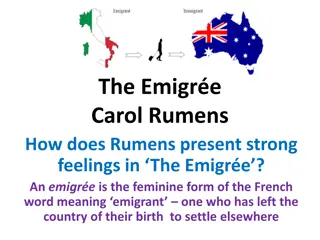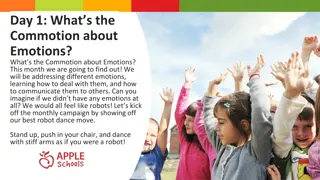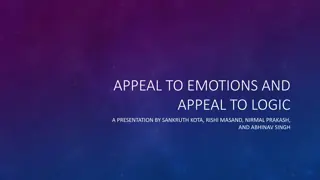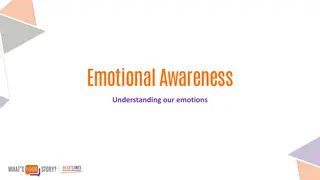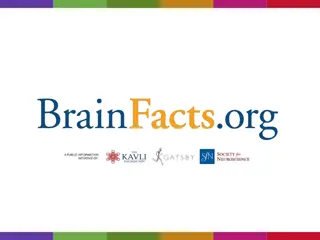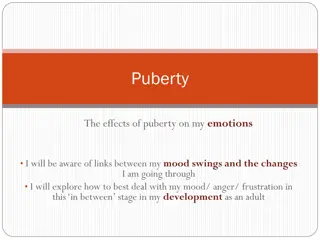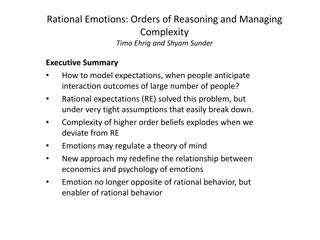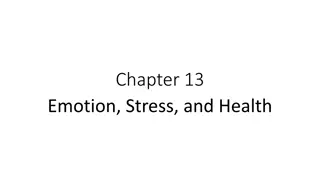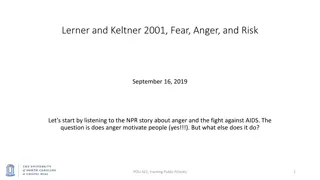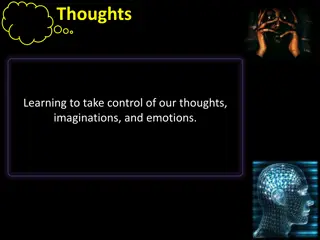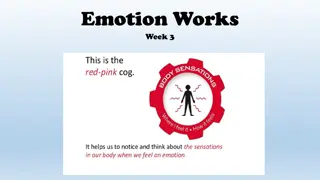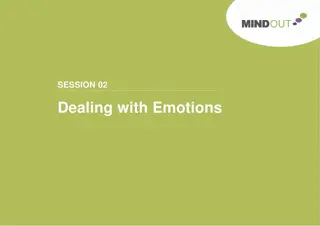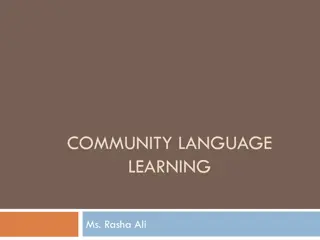The Impact of Emotions on Language Learning
Exploring the influence of emotions on language acquisition, referencing works by Glenda Sacks, Rebecca Levie, David Brooks, Damasio, Stephen Krashen, and Mary Helen Immordino-Yan. Positive emotions enhance learning outcomes, while anxiety and negative emotions hinder the process. The importance of creating an anxiety-free environment for effective language acquisition is highlighted, emphasizing the interconnectedness of emotions, social interactions, and learning success.
Download Presentation

Please find below an Image/Link to download the presentation.
The content on the website is provided AS IS for your information and personal use only. It may not be sold, licensed, or shared on other websites without obtaining consent from the author. Download presentation by click this link. If you encounter any issues during the download, it is possible that the publisher has removed the file from their server.
E N D
Presentation Transcript
Creating Empathy in the EFL Classroom Glenda Sacks and Rebecca Levie 1
Language Learning and Emotions David Brooks , author, teacher and political commentator recently published an article in the New York Times on January 18th, 2019 titled Students Learn from People They Love, highlighting the importance of positive emotions in the learning process. 2
Damasio ( 1999) writes: emotion probably assists reasoning, especially when it comes to personal and social matters involving risk and conflict . (41-42) Risk is part of the school experience where the risk of failing hangs over students. 3
Conversely, Brooks goes on to point out how extreme negative emotions, like fear, can have a devastating effect on a student s ability to learn. 4
The Need to Create an Anxiety- Free Environment Stephen Krashen (1992) notes that low anxiety is correlated with more success in language acquisition, that is, anxiety inhibits language learning. P. Lou, D. Tucker and D. Derryberry (1998) uphold Krashen s hypothesis by noting that anxiety constrains cognition by biasing attention towards the anticipation of the threat. (577) 5
Clearly, according to Damasio, Krashen and Brooks, both positive and negative emotions have a considerable impact on the learning process. 6
A New Awareness of the Influence of Fellow Students in the Classroom, on Learning and Anxiety (Social Processing) Mary Helen Immordino-Yan (2011), a colleague of Damasio, notes that neuro- scientific evidence links emotion, social processing and self, which suggests a new approach to understanding teaching. She says: Neuro-scientific evidence suggests that we can no longer justify learning theories that dissociate the mind from the body, the self from social context (p. 101). 7
Furthermore, Immordino-Yan claims that To learn, students empathically recognize the teacher s actions, thoughts and goals, a process that reflects each student s own social and cognitive experiences and preferences (p. 101). 8
Parker J. Palmer (1993) affirms the importance of empathic social relationships between the students themselves as well as the teacher when he writes that real learning does not happen until the students are brought into relationship with the teacher, with each other, and with the subject (p. 3). 9
Creating a Sense of Unity in the Classroom. The aim of this presentation is ALSO to demonstrate ways to create a gibbush, a feeling of empathy, between the students themselves. This will allow them to feel free to express themselves, make mistakes and show compassion for each other while they learn together. 10
How to Create an Empathic Environment in the Classroom? At the start of the semester The teacher shows an understanding of the difficulties of learning English and exposes her/his weaknesses. 11
Breaking the Ice Student activities for the first lesson: Students are paired up and have to interview each other, and then report back about their partner. According to CEFR Can-Dos: Interaction / Spoken Conversation. Can follow clearly articulated speech directed at him/her in everyday conversation. Interaction / Spoken Information exchange. Can find out and pass on straightforward factual information. 12
Students each write a short paragraph with the title What I have learned They describe a life experience or event which changed their life. The teacher reads the paragraphs to the class. 13
Student Activities which Enhance the Empathic Environment in the Class: Group work: Students have to (in pairs) choose a position in an opinion paper or an email/letter and work on the assignment together. 14
Students are asked to share interpretations related to art, images and literature. Varying interpretations of the same image creates dynamic interactions in the class. 16
EXAMPLE OF COLLABORATIVE WRITING AND PEER EVALUATION: Writing example: Esther, Ethan and Nora This NYT article discusses about plagiarism among students at university. Nowdays, students have no awareness of plagiarism and how it can hinder their learning. They cut and past their informations without quoting. Staples purpose in his article is to prevent plagiarism for students to remain authentic and original. University Students nowadays copy someone elses work without giving credit, whether ist intentionally or unintentionally. The author tries to find ways to prevent to help students to be more original. Karen&Sara Staples in his article highlights nowadays plagiarism issue at the University. According to him, cutting and pasting challenge students learning, in order to prevent this issue for original s students writing. EL Every year, many students commit plagiarism with no awareness about it whatsoever. This is an act described as counterproductive for them, which interfere with their education. Tammy, Noga & Ori Staples article discusses the issue of plagiarism in academia and how unawareness hinders the learning process. The author's goals are preventing plagiarism and encouraging originality. Jacob, Allison, Ray Staples s article discusses plagiarism in universities by students who are ignorant of its consequences and emphasizes the need for creativity instead. ---- Ron The problem of plagiarism is, as we can see, in the two articles, a big problem in universities. In fact, students are not aware that when they want to use someone else information, they need to quote their source. According to the first article by Brent Staples Cutting and Pasting : a senior thesis., we can see that because of the plagiarism, students are no longer able to produce a personal and original assignment. Through the second article Plagiarism lines blur for students in digital age the author shows us how the new generation can t do without plagiarism and how it became common. As the intellectual property becomes unclear in the internet age everything seems as a common knowledge. ANONYMOUSSSS!! 18
How all These Activities Conform to the CEFR Aligned Framework for Higher Education in Israel. Production / Speaking Sustained monologue: Describing experience; Can give detailed accounts of experiences, describing feelings and reactions, and can describe events (adapted Mitkadmim Aleph) Reception / Listening - Listening as a member of a live audience: Can follow a lecture or talk provided the subject matter is familiar and the presentation is straightforward and clearly structured (adapted B1+) Production / Writing Reports and essays: Can summarize a short academic text on general subjects that do not require field-specific/expert knowledge. Production / Writing Overall written production: Can write a paragraph comprising a series of sentences linked with appropriate connectors, such as "and", "but", and "because." 19
Brain-to-Brain Synchrony The effectiveness of these classroom activities has been demonstrated by Suzanne Dikker et al.(2017) who recorded the brain activity of a group of 12 students simultaneously for 11 school days. She found that brain- to-brain synchrony between students consistently predicted class engagement and social dynamics (p. 1385). actual joint attention and not passive co-presence predicted student to student synchrony. (p. 1379) 20
Empathic Responses of the Teacher to Student Participation in the Class: Enthusiastically praise good answers. Write up worthy answers on the board and include the student s name in brackets which encourages others to answer. Praise the class as a group as it creates a sense of belonging. For example, if they are particularly conscientious, tell them that they are an excellent group of students. 21
Empathic Assessment and Evaluation is Crucial for the Creation of Empathy Between Student and Teacher. Instead of dismissing a wrong answer, teachers should find something positive in the answer in the following ways: Show an understanding for the student s reasoning. Gently redirect the student s thinking. Thank the student for the wrong answer, because it gives an opportunity to teach something. 22
Evaluating Projects When evaluating oral presentations: Teachers should respond with gratitude to the student for sharing their ideas and experiences with the class. Always begin feedback with a positive remark about the presentation. Then, gently make suggestions for improvement in the future. 23
Discipline in the Empathic Classroom: If one creates a feeling of empathy and camaraderie amongst the students in the class, students undertake to discipline each other. When students see another student being disrespectful to a teacher they love (Brooks), they will tell the student to be quiet. Avoid confrontation in the classroom because it alienates the class from the teacher. Rather, discipline a student outside the class. 24
To Conclude: Jane Tompkins (1996) perfectly sums up the stresses of the classroom experience when she writes: In class discussion, students compete with one another for the teacher s approval. They seek reassurance, and they want to be rewarded with praise. It s a performance they are engaged in, not a spontaneous utterance, and a performance on which a lot depends; their own self-esteem, the regard of their fellow students, the good opinion of the teacher, and ultimately, their grade and their grade point average. There are many ways to fail. (p. 210). 25
Tompkins solution to this stressful situation is to make the classroom a safe place the way home is supposed to be (p. 127). The best way to achieve a safe place and to create an effective learning environment is to foster a sense of empathy between students and teacher in the EFL classroom. 26
THANK YOU REBECCA LEVIE - rebecca.haddad120@gmail.com GLENDA SACKS hagal56@netvision.net.il 27
Bibliography: Brooks, D. Students learn from people they love. New York Times. January 18, 2019. Damasio, A. (1999). The Feeling of What Happens: Body and Emotion in the Making of Consciousness. Orlando: Harcourt Incorporated. Dikker, S., Wan, L. and Davidesco, I. (2017). Brain-to-brain synchrony tracks real-world dynamic group interactions in the classroom. Current Biology 27 (9 ), 1375-138. Immordino-Yang, M. H. (2011). Implications of affective and social neuroscience for educational theory. Educational Philosophy and Theory 43 (1). 98-103. Krashen, S. (1993). The comprehension hypothesis extended. In T. Piske and M. Young- Scholten (Eds.) Input Matters in SLA, (pp.81-94). Bristol: Multilingual Matters. Luu, P., Tucker, D. M., and Derryberry, D. (1998). Anxiety and the motivational basis of working memory. Cognitive Therapy and Research. 22(6). 577-594. Palmer, P. (1993). To Know as We Are Known: A Spirituality of Education. New York: Harper-Collins. Therrell, J. A. and Dunnebeck, S. K. (2015). Millennial perspectives and priorities. Journal of Scholarship and Teaching 15 (5). 49-63. Tompkins, J. (1996). A Life in School: What the Teacher Learned. New York: Basic Books. 28




